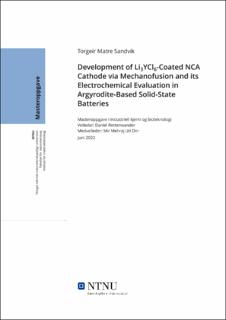| dc.contributor.advisor | Rettenwander, Daniel | |
| dc.contributor.advisor | Mir Mehraj Ud Din | |
| dc.contributor.author | Sandvik, Torgeir Matre | |
| dc.date.accessioned | 2022-10-22T17:23:03Z | |
| dc.date.available | 2022-10-22T17:23:03Z | |
| dc.date.issued | 2022 | |
| dc.identifier | no.ntnu:inspera:108213079:32674898 | |
| dc.identifier.uri | https://hdl.handle.net/11250/3027675 | |
| dc.description.abstract | De siste årene har det vært en betydelig utvikling innen forskning på faststoffbatterier
(SSB). Imidlertid har de tekniske utfordringene, inkludert inkompatibilitet i grenses-
nittet mellom elektrode og elektrolytt på grunn av (elektro)kjemisk ustabilitet eller
gitterforskyvning osv. hindret kommersialiseringen av denne batteriteknologien. Ved
å dra nytte av dens høye Li+-ledningsevne ved romtemperatur og høye prosesser-
barhet, har den faste elektrolytten Li6PS5Cl (LPSC) blitt et mye benyttet materiale i
SSB-forskning. Imidlertid hindrer det smale elektrokjemiske vinduet til LPSC dets
integrasjon med høyspentkatoder for å oppnå praktiske energitettheter. For å omgå
problemene knyttet til grensesnittinkompatibilitet, utforskes sjeldne jordartshalider for
tiden som lovende mellomlag eller beleggmaterialer for høyspentkatoder brukt i SSB-
er som inneholder SE-er av argyrodittype.
Denne oppgaven forsøker å undersøke Li3YCl6 (LYC)-belagt LiNi0.8Co0.15Al0.05O2
(NCA) for å fremme LPSC i SSB. NCA ble tørrbelagt ved mekanofusjon og undersøkt
av Fokusert ionestråle-Scanning elektronmikroskop og Scanning transmisjonselek-
tronmikroskop (STEM). Uberørte og LYC-belagte NCA-elektroder ble forberedt og
brukt i myntceller med toppmoderne flytende elektrolytt og i SSB-er. Et porøst, ca. 20
nm tykt og kontinuerlig belegg ble observert ved STEM-avbildning av NCA-katoden
belagt med 3 vektprosent LYC. Celler med flytende elektrolytt leverte lav første ut-
ladningskapasitet på 120,2 mAh / g og 117,2 mAh / g for celler med henholdsvis
1,5 vektprosent og 3 vektprosent LYC-belegg. Den første Coulombiske virknings-
graden (ICE) var på henholdsvis 31,1 % og 39,4 %. Den første utladningskapasiteten
til cellene med uberørt NCA og som inneholdt flytende elektrolytt var 176,4 mAh / g
og ICE var 89,6 %. På den annen side viste SSB-ene betydelig forbedring i utlad-
ningskapasitet fra 8,50mAh / g for uberørt NCA til 100 mAh / g og 113 mAh / g
for henholdsvis 1,5 vektprosent og 3 vektprosent LYC-belagt NCA, og ICE var hen-
holdsvis 8,74 %, 57,8 % og 56,9 %. Fra de elektrokjemiske undersøkelsene av cellene
med flytende elektrolytt og faststoffcellene, ble det konkludert med at LYC var grunn-
leggende ustabil i kontakt med NCA ved spenningen som ble brukt (4,3 V vs Li/Li+)
for batterisykling. Selv om LYC-belegget betydelig forbedret den elektrokjemiske
ytelsen til SSB-ene, indikerte den gradvise kapasitetsforverringen en sannsynlig mate-
rialforringelse i grensesnittet mellom katode og LYC. For å ytterligere kunne forbedre
ytelsen til SSB-er er et grunnleggende stabilt beleggmateriale svært ønskelig. | |
| dc.description.abstract | Recent years have witnessed significant development in all-solid-state batteries (SSBs)
research. However, the technical challenges including the electrode-electrolyte inter-
face incompatibility due to (electro) chemical instabilities or lattice mismatch etc.
have impeded the commercialisation of this battery technology. Benefiting from its
high Li+ conductivity at room temperature and ease in processibility, Li6PS5Cl (LPSC)
solid electrolyte (SE) has been a material of choice in SSB research. However, the
narrow electrochemical window hinders its integration with high voltage cathodes to
achieve practical energy densities. To circumvent the issues related to interface incom-
patibility, rare-earth halides are explored currently as promising interlayers or coating
materials for high-voltage cathodes used in SSBs containing argyrodite-type SEs.
This thesis is an attempt to investigate Li3YCl6 (LYC)-coated LiNi0.8Co0.15Al0.05O2
(NCA) to facilitate LPSC in SSBs. NCA was dry-coated by mechanofusion and inves-
tigated by Focused Ion Beam-Scanning Electron Microscopy and Scanning Transmis-
sion Electron Microscopy (STEM). Pristine-and LYC-coated NCA electrodes were
prepared and utilised in coin cells with state-of-the-art liquid electrolyte and in SSBs.
A porous, approximately 20 nm thick and continuous coating was observed by STEM
imaging of the NCA cathode coated with 3 wt% LYC. Liquid electrolyte-containing
cells delivered low initial discharge capacity of 120.2 mAh / g and 117.2 mAh / g
for cells with 1.5 wt% and 3 wt% LYC-coating, respectively. Initial Coulombic ef-
ficiency (ICE) was 31.1% and 39.4%, respectively. Initial discharge capacity of the
pristine NCA cycled in liquid electrolyte-containing cells was 176.4 mAh / g and ICE
was 89.6%. On the other hand, SSBs showed significant improvement in discharge ca-
pacity from 8.50 mAh / g for pristine NCA to 100 mAh / g and 113 mAh / g for 1.5
wt% and 3 wt% LYC-coated NCA, respectively, and the ICE was 8.74%, 57.8% and
56.9%, respectively. From the electrochemical investigations of the liquid electrolyte-
containing cells and SSBs, it was concluded that LYC was inherently unstable in con-
tact with NCA at the voltages utilised (4.3 V vs Li/Li+) for battery cycling. Although
the LYC coating significantly improved electrochemical performance of the SSBs, the
gradual capacity fading indicated the possible material degradation at the electrode
interface. To further improve the performance of SSBs an intrinsically stable coating
material is highly desirable. | |
| dc.language | eng | |
| dc.publisher | NTNU | |
| dc.title | Development of Li3YCl6-Coated NCA Cathode via Mechanofusion and its Electrochemical Evaluation in Argyrodite-Based Solid-State Batteries | |
| dc.type | Master thesis | |
